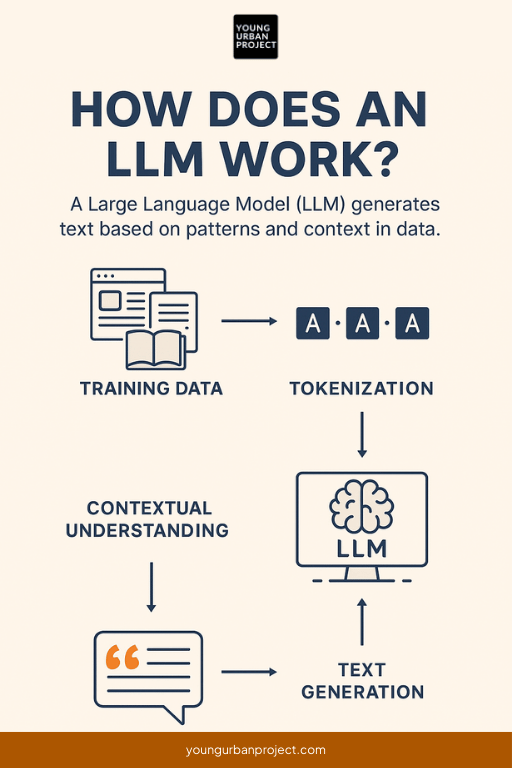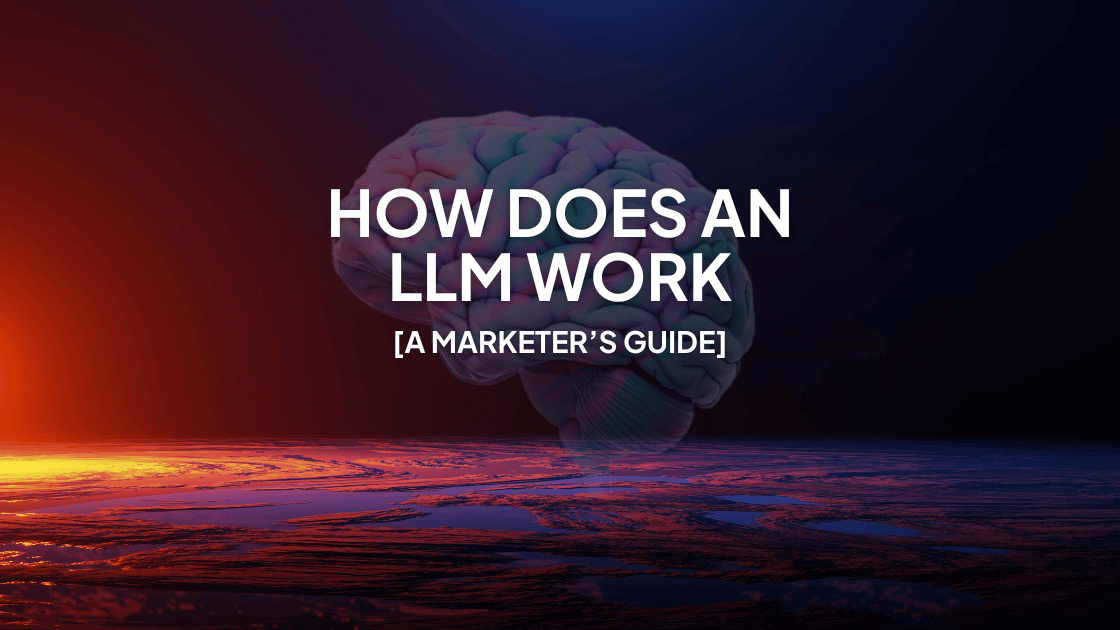If you’re a marketer from 2025 and beyond, chances are you’ve already used ChatGPT, Gemini, Perplexity, Copy.ai, or one of those flashy AI content tools. You type something, and poof – out comes a blog post, ad copy, or product description that feels like magic.
Table of Contents
But here’s the thing: it’s not magic.
It’s the result of some wild technology called an LLM, or Large Language Model.
And the better you understand how does an LLM work – even if in a non-technical way – the better you’ll be at using it strategically, ethically, and creatively in your marketing efforts.
Let’s break it down.
So, What Exactly is an LLM?
At its core, a Large Language Model is a type of artificial intelligence trained to predict the next word in a sentence. That’s it. It sounds simple, but it leads to incredibly complex and powerful behavior.
Imagine you’re playing a game where someone says:
“Once upon a…”
You might guess the next word is “time.” Because you’ve seen that phrase a million times.
That’s basically what an LLM does – but at superhuman speed, across trillions of examples, in hundreds of languages, and on nearly every topic you can imagine.
LLMs like OpenAI’s ChatGPT, Anthropic’s Claude, Google’s Gemini, and Meta’s LLaMA have been trained on enormous datasets made up of books, websites, Wikipedia, news articles, Reddit threads – you name it.
They don’t “know” facts the way humans do.
They predict language based on patterns they’ve learned.
How Does an LLM Work? The Non-Techy Breakdown

🧠 Step 1: Training
LLMs are trained on massive amounts of text — think the entire open internet (minus the creepy stuff).
This training is like feeding a machine examples of how humans write, speak, argue, ask questions, and tell stories.
Over time, the model learns statistical patterns:
- What words tend to follow others
- How grammar structures work
- What tone looks like in different contexts
It’s kind of like a hyper-intelligent autocomplete, but 10,000x more sophisticated.
🔁 Step 2: Token Prediction
LLMs don’t process full words the way we do. Instead, they break down text into “tokens” – which are usually parts of words.
For example:
- “Marketing” might be split into “Market” + “ing”
- “Facebook Ads” might be “Face” + “book” + “Ads”
The model then guesses what token comes next, based on probabilities.
Think: “There’s a 92% chance the next word is ‘campaign,’ but maybe 5% it’s ‘strategy,’ and 2% it’s ‘budget.’”
And it does this repeatedly, word by word, until it generates a coherent response.
Important: LLMs have No Awareness
LLMs don’t “think.” They don’t “understand” your question like a human would.
They’re just playing an ultra-fast guessing game based on patterns.
But because the patterns are so deeply trained, the results feel eerily human.
Also Read: What is an LLM in Generative AI?
Why Should Marketers Even Care?
Now, while you have understood how does an LLM work, you must be wondering “What has it got to do with me? A Marketer?”. Because LLMs are quietly revolutionizing every part of marketing.
Here’s how:
- Content Creation: Blogs, emails, captions, scripts — generated in seconds.
- Ad Copywriting: Test 10 variations of a headline in minutes.
- SEO Strategy: Generate keyword ideas and meta descriptions on the fly.
- Customer Support: Chatbots that actually sound human.
- Personalization: Dynamic content for different customer segments, without writing each version from scratch.
If you know how to prompt the LLM properly, it becomes your smartest intern, your copywriting buddy, and your brainstorming partner all in one.
Enroll Now: Advanced Generative AI for Marketing
LLMs vs Old-School Automation
Remember those basic chatbots from 2018? The ones that said “Hi, I’m Botty. Type ‘1’ for support”? Yeah… LLMs make those look like dial-up internet.
There’s a clear difference between how traditional AI works, and how does an LLM work.
Old AI: Rule-based, rigid, predictable.
New AI (LLMs): Fluid, generative, context-aware.
That’s why tools like ChatGPT feel different – they don’t just follow rules. They generate responses on the fly, based on your specific input.
Also Read: Generative AI vs Predictive AI: Key Differences
Common Misconceptions About LLMs (That Marketers Fall For)
Let’s bust a few myths:
- “LLMs are always accurate.”
Nope. They sound confident, but they can hallucinate (make things up). Always fact-check. - “They think like humans.”
LLMs don’t “think.” They don’t have beliefs, opinions, or consciousness. They just mimic the structure of language. - “They’re up-to-date with everything.”
Many models are trained on data that’s months (or years) old. Some have internet access, some don’t.
Real-World Applications for Marketers Using LLMs
Now that you are clear on how does an LLM work, here’s how smart marketers are actually using LLMs today:
✍️ Copywriting
Write 20 product descriptions in the brand’s tone. Create email subject lines with different emotional triggers. It’s speed and quality.
Also read: 16 Types of Copywriting Every Marketer Must Know
📈 SEO Content Strategy
Get blog ideas from a single keyword. Build outlines. Create pillar-cluster content models. Even write optimized first drafts.
Also Read: Build A Social Media Marketing Strategy in 7 Steps
🤖 AI Customer Support
Fine-tuned LLMs can handle FAQs, order issues, and even empathetic responses – 24/7, in multiple languages.
🧠 Marketing Strategy & Research
Need a summary of a new social trend? Or a competitor analysis? Or a breakdown of Gen Z behavior? Prompt an LLM with the right instructions and get clarity fast.
Also Read: What is Business Research?
🎯 Personalization at Scale
Generate different ad creatives for different personas. No need to write 15 versions manually – the LLM can handle it.
Prompt Engineering: The Secret Skill No One Taught You in School
Prompting is how you “talk” to an LLM.
It’s a mix of creativity, specificity, and structure.
Example:
Instead of saying:
“Write me a Facebook ad.”
Try this:
“Write a Facebook ad promoting a 5-day free AI course for marketers. Keep the tone friendly and witty. Emphasize time-saving and career growth.”
Better input = better output.
This is where great marketers will separate themselves from average ones. Prompting is the new briefing.
Ethical Concerns & Risks with LLMs
LLMs are powerful, but not perfect.
- Bias: They can reflect harmful or outdated stereotypes from their training data.
- Voice Drift: If you rely too much on AI, your brand voice can become generic.
- Overuse: Using AI everywhere can make content feel soulless if you’re not careful.
You need human oversight. Think of the AI as your assistant, not your replacement.
The Future: LLMs Are Just Getting Started
Imagine:
- AI tools that know your brand tone better than your junior copywriter.
- Real-time content personalization based on user behavior.
- Voice-activated marketing assistants that run entire campaigns.
This isn’t sci-fi. It’s next quarter.
And marketers who lean in now – who learn to collaborate with LLMs – will be miles ahead.
Conclusion: Embrace the AI + Human Combo
You don’t need to be a machine learning engineer to use LLMs.
You just need curiosity, creativity, and a bit of marketing common sense.
The marketers who understand how LLMs work — even at a high level — will be able to use them not just for tasks… but for transformation.

